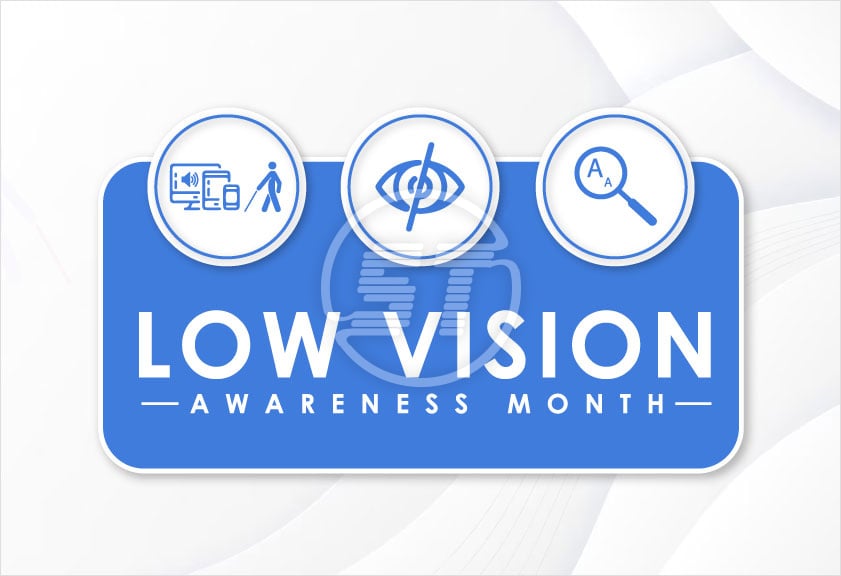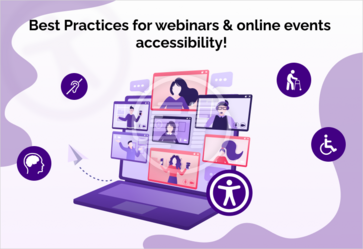February is declared as a low vision awareness month to improve cognizance of digital accessibility. Also, spreading the words more about accessibility is the key idea so that people with low vision can access digital spaces conveniently.
But why is it needed? Well, according to Disability Statistics (2016), number of visually disabled users in the US was more than 7.6 million in adults. Moreover, the National Eye Institute has predicted that by 2050 the number of people with low vision or blindness will be double the current numbers. These increasing numbers of disabled users (low vision or blind) are the reason behind such initiatives.
Low Vision Awareness Month aims to disseminate information to individuals in need of assistance as well as organizations capable of providing necessary and pertinent support for disabled users.
A person with age-related macular degeneration, glaucoma, cataracts, and diabetic retinopathy comes under the low vision segment. Such individual who suffers from partial sight or sight that cannot be corrected completely with surgery or medication need special attention not only in other aspects of life but in digital spaces as well.
Individuals experiencing low vision confront numerous challenges when accessing digital content. Therefore, it's essential to minimize accessibility barriers that limit the user experience, and because of this, we must all comprehend the importance of accessibility compliance.
Let’s understand low vision awareness and digital accessibility.
How does digital accessibility affect the whole spectrum of visual disability?
Digital accessibility focuses on a broader spectrum of every type of disability including permanent, temporary, and situational disabilities. Low vision issues can fall in any of these three types for different users. Website owners need to identify different types of visual issues to ensure precisely correct implementation of elements that are accessible to low-vision users.
When a design is user-centric, it is made keeping all the mandatory requirements in the loop to offer seamless experiences. For instance, users with permanent low vision might use screen readers to understand the content. Thus, the website content should be compatible with screen readers. However, a user with temporary low vision from an injury would typically opt for alternative solutions like text zooming or audio transcripts for video content rather than using a screen reader. Additionally, visual flashing elements can pose difficulties for users with vision impairments.
Acknowledging and accommodating these diverse needs of users and creating digital designs accordingly is a much-needed way to promote accessibility. Moreover, the inclusive approach is beneficial for a broader segment of users across distinct contexts and conditions.
What accessibility implementations can be done to promote the idea of this initiative?
Low Vision Accessibility Awareness Month is a critical campaign launched to increase the odds of more people talking about digital accessibility.
Digital accessibility covers a vast area of digital tools and technologies. Electronic devices, computer-access software, magnification devices, etc. are used by people with low vision to maximize exploration and understand digital content. The users with low vision mostly use their sense of touch or hearing to consume the content but that will be only possible if the content adheres to WCAG standards.
A good design with a cohesive user experience requires the application of collaborative design practices and regular improvement.
So, for cohesive user experience, organizations need to shift their focus from individual touchpoints to users’ end-to-end journey. User persona creation helps understand them better and it is equally important to attract and engage users with low vision.
Thorough testing of a minimum viable product is crucial to identify potential areas of difficulty for users with low vision. This involves employing both real-user testing and code testing methodologies.
In addition, there should be a culture of continuous improvement. Regular updates to digital content are necessary, and this process can be facilitated smoothly by ensuring that developers and designers are continuously trained and upskilled with the latest WCAG standards and other accessibility tools.
Wrapping up
In a nutshell, digital accessibility is not just compliance with suggested legal standards; it is about creating a culture of inclusivity. So, discuss more about low vision and other spectrum of disabilities and try to identify more ways to inculcate accessibility practices. And that is what the main idea behind Low Vision Awareness Month is to encourage more tech organizations to infuse accessibility into their digital assets and promote other to do the same.
Possibilities are endless that reflect the diversity of human experiences. Organizations only need to adopt the correct approach!
Whether you are providing digital information or conducting online business, our expert digital accessibility services will help you optimize your digital platform. At Skynet Technologies, we provide tailored digital accessibility solutions for small, medium, large enterprises, ecommerce, state and federal government entities, law firms, and non-profit organizations to ensure inclusivity and ADA compliance. Contact us at hello@skynettechnologies.com for more information.


